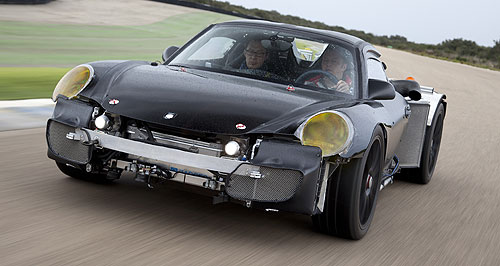Future models - Porsche - 918 - SpyderPorsche’s $1.3 million ‘hack’Hot hybrid: Porsche’s 918 plug-in supercar can hit 325km/h, sprint to 100k/h in three seconds and drink just 3.0L/100km. 918 hybrid supercar ‘mule’ put through its paces by Porsche to show off its moves26 Mar 2012 IT MIGHT look like a farm teenager’s paddock-basher right now, but this cobbled-up clunker is set to blossom into the most expensive, most fuel-efficient and swiftest road-going Porsche ever devised once it goes on sale in strictly limited numbers from late 2013. The plug-in hybrid Porsche 918 Spyder prototype – cloaked in a mix of 911 panels and other makeshift bits – was put through its paces in early development ‘mule’ form at Italy’s Nardo test track last week to show off its 21st century technology. The mid-engined supercar can blast from zero to 100km/h in less than three seconds while sipping about 3.0 litres of petrol per 100km – better than the benchmark Toyota Prius hybrid’s 3.9L/100km. Porsche predicts the 918’s combination of battery-powered electric motors and race-based 4.6-litre V8 petrol engine will propel it around the Nurburgring in “less than” 7:22 minutes – at least 10 seconds faster than the legendary V10 Carrera GT (7:32 minutes), while also eclipsing the Nissan GT-R’s 7:24.2 lap set in 2010. Yet the 918 is claimed to emit just 70 grams of carbon-dioxide per kilometre, compared with the official Prius figure of 89g/km. The car will be built only in left-hand drive and priced at €645,000 in Europe – or about $1.29 million in Australia if someone wants one for their garage collection and is willing to pay a bucket of luxury car tax for the privilege.  The 918 is expected to be joined by a plug-in version of the Panamera sedan in about 2014, for a somewhat more affordable price. The 918 is expected to be joined by a plug-in version of the Panamera sedan in about 2014, for a somewhat more affordable price.The German manufacturer used last week’s Nardo event to confirm further details of the 918 supercar, which will have a carbon-fibre-reinforced plastic body, a race-car-like 574kW of power and the thirst of a tiny city car. The two-seat sportscar is equipped with two electric motors – an 80kW motor driving the front wheels and a 90kW motor sandwiched between the mid-mounted 425kW V8 engine and dual-clutch transmission driving the rear wheels. The electric motors draw power from a 6.8kWh lithium-ion battery that is liquid-cooled and can be charged from a power point for a full-charge electric-only range of about 25km. Both electric motors can be run in parallel with the V8 engine or decoupled according to need. The car’s powertrain has five selectable modes, ranging from a frugal E-Power default mode to full-bore Hot Lap using the full electric power. In-between modes are Hybrid, Sport Hybrid and Race Hybrid, which progressively ramp up the electric drive at the expense of battery capacity. The petrol engine is derived from the 3.4-litre racing V8 the powers the Porsche RS Spyder race car, employing race-style dry-sump lubrication with plastic extraction pumps to save weight. The naturally aspirated engine revs to 9000rpm and develops 93kW of power per litre, eclipsing the Porsche Carrera GT’s 80kW per litre. Top speed is said to be 325km/h, or 150km/h on electric power alone. Unusually, the V8 engine has its intake manifolds on the outside of the engine ‘V’, with the exhaust extractors on the inside. Porsche says this “top-pipe” arrangement – a first for a production car – keeps the exhaust back-pressure low by venting the gases via the shortest route: straight up and out. It also keeps the engine bay cooler, helping the electrical components – including the battery pack – to operate at a more optimal temperature and reduce the need for cooling. The rear wheels can be driven by the petrol engine, electric motor or both, depending on need. There is no mechanical connection between the rear powertrain and the front axle, which can be driven independently by electric motor, creating a form of all-wheel drive that Porsche says offers “great potential for traction and driving dynamics”. The lithium-ion battery has 312 cells, and comes with its own charging station to be installed in the owner’s garage. This system can fully charge the battery in two hours, or the car can be charged in four hours from a standard 10-amp socket. As well, the 918 features a new-generation hybrid regenerative braking system that Porsche claims is more effective than systems used elsewhere. The system uses both electric motors to apply braking force through all four wheels, equivalent to a driver pressing on the brake pedal with 11kg of force – three times the energy of current systems. As well, the supercar is equipped with ceramic disc brakes to provide the rest of the stopping power.  Read more |
Click to sharePorsche modelsResearch Porsche Motor industry news |


























Facebook Twitter Instagram